A carbine, from French carabine, is a long gun firearm but with a shorter barrel than a standard rifle or musket. Many carbines are shortened versions of full-length rifles, shooting the same ammunition, while others fire lower-powered ammunition, including types designed for pistols.

A firearm is a gun designed to be readily carried and used by a single individual. It inflicts damage on targets by launching one or more projectiles driven by rapidly expanding high-pressure gas produced by exothermic combustion (deflagration) of chemical propellant. If gas pressurization is achieved through mechanical gas compression rather than through chemical propellant combustion, then the gun is technically an air gun, not a firearm. Some legal definitions of "firearm" are more broad, and may cover any and all projectile devices, or even other destructive devices.
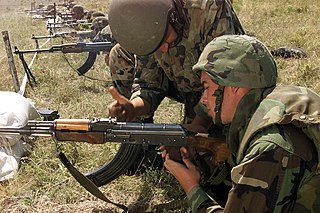
A squad automatic weapon (SAW), also known as a section automatic weapon or light support weapon (LSW), is a fully automatic firearm used to give infantry squads or sections a man-portable source of fully automatic firepower. Weapons used in this role are often selective-fire rifles, usually fitted with a bipod and heavier barrel to perform as light machine guns. Squad automatic weapons usually fire the same cartridge as the assault rifles or battle rifles carried by other members of the unit. This reduces logistical requirements by making it only necessary to supply one type of ammunition to a unit. Squad automatic weapons are light enough to be operated by one person, as opposed to heavy machine guns such as the M2 Browning, which fire more powerful cartridges but require a crew to operate at full effectiveness.
The FAL is a battle rifle designed by Belgian small arms designer Dieudonné Saive and manufactured by FN Herstal.

The M1 Garand is a .30-06 caliber semi-automatic rifle that was the standard U.S. service rifle during World War II and the Korean War and also saw limited service during the Vietnam War. Most M1 rifles were issued to U.S. forces, though many hundreds of thousands were also provided as foreign aid to American allies. The Garand is still used by drill teams and military honor guards. It is also widely used by civilians for hunting, target shooting, and as a military collectible.

The StG 44 is a German selective-fire rifle developed during World War II. It is also known as the MP 43 and MP 44.
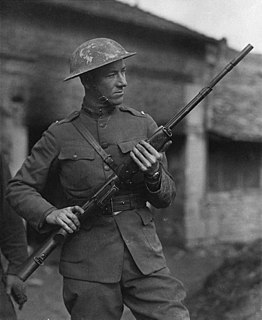
An automatic rifle is a type of self-loading rifle that is capable of automatic fire. Automatic rifles are select-fire weapons that are capable of firing in semi-automatic and automatic firing modes. Automatic rifles are distinguished from semi-automatic rifles in their ability to fire more than one shot in succession once the trigger is pulled. Most automatic rifles are further subcategorized as battle rifles.
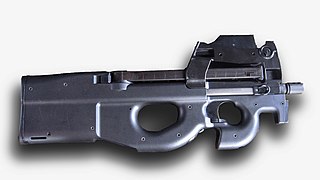
Personal defense weapons (PDWs) are a class of compact, selective fire, magazine-fed, submachine gun-like firearms—essentially a hybrid between a conventional submachine gun and a compact assault rifle. Most PDWs fire a small-caliber, high-velocity centerfire bottleneck cartridge resembling a scaled down/shortened intermediate rifle cartridge. This gives the PDWs better effective range, accuracy and armor-penetrating capability than submachine guns, which fire the larger-caliber handgun cartridges.

The .30 Carbine (7.62×33mm) is a rimless carbine cartridge used in the M1 carbine introduced in the 1940s. It is a light rifle round designed to be fired from the M1 carbine's 18-inch (458 mm) barrel.
Luigi Franchi S.p.A. is an Italian manufacturer of firearms, a division of Beretta Holding.
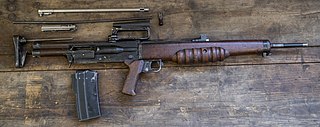
The EM-2, also known as Rifle No.9 Mk1 or Janson rifle, was an experimental British assault rifle. It was briefly adopted by British forces in 1951, but the decision was overturned very shortly thereafter by Winston Churchill's incoming government in an effort to secure NATO standardisation of small arms and ammunition. An innovative weapon with the compact bullpup layout and an optical sight, it used one of the early intermediate cartridges as a result of combat experience and German advances in weapons design during World War II.

The .276 Pedersen (7×51mm) round was an experimental 7 mm cartridge developed for the United States Army. It was used in the Pedersen rifle and early versions of what would become the M1 Garand.
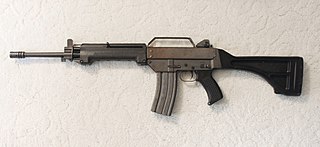
The Leader T2 MK5 Series firearms were chambered for the 5.56×45mm NATO cartridge and manufactured by Leader Dynamics of Smithfield, NSW, Australia (1978-1982/1983). The Leader was the brainchild of weapons designer Charles St. George. It was originally a contender for a 5.56 mm Australian military service rifle to replace the then-issued Lithgow L1A1-F1 SLR and Colt M16A1 rifles. What was unique about this endeavor was that Australia had never designed or manufactured its own commercial gas-operated semi-automatic rifle. The rifle was abandoned when the Steyr AUG was adopted for use by the Australian military.
The G41 is a German 5.56×45mm NATO assault rifle introduced in 1981 and produced in limited quantities by Heckler & Koch. It was designed to replace the 5.56mm Heckler & Koch HK33 in service providing a more modern weapon compatible with contemporary NATO standards. It is chambered for the 5.56×45mm NATO cartridge and can use both SS109 and M193 ammunition. Assembly of the G41 has been discontinued by Heckler & Koch; however, production rights to the rifle were acquired by the Italian arms manufacturer Luigi Franchi.

The Beretta BM 59 is an Italian-made rifle based on the M1 Garand rifle, but chambered in 7.62×51mm NATO, and modified to use a detachable magazine. Later revisions incorporated other features common to more modern rifles.

An intermediate cartridge is a rifle/carbine cartridge that is shorter than typical full-power battle rifle cartridges, but still has greater length than pistol/personal defense weapon cartridges. As their recoil is significantly reduced compared to full-power rifle cartridges, fully automatic rifles firing intermediate cartridges are relatively easy to control. However, even though less powerful than a traditional full-power rifle cartridge, the ballistics are still sufficient for an effective range of 300–600 metres (330–660 yd), which are the maximum typical engagement ranges in modern combat. This allowed for the development of the assault rifle, a selective fire weapon that is more compact and lighter than rifles that fire full-power rifle cartridges.
The Beretta AR70/90 is a gas operated rifle chambered for the 5.56×45mm NATO cartridge, and is the standard issue service rifle of the Italian Armed Forces. The weapon is also designed to be fitted with a rifle grenade, and has grenade sights. The AR series comes in many variants such as the AR90, with a wire folding stock, for use by paratroopers.

The Beretta ARX160 is an Italian modular rifle manufactured by Beretta. Developed for the Italian Armed Forces as part of the Soldato Futuro program, the ARX160 was launched in 2008 as a commercial weapon system independent from the Soldato Futuro ensemble, complete with a companion single-shot 40×46mm NATO low-velocity grenade launcher, called the GLX160, which can be mounted underneath the rifle or used with an ad hoc stock system as a stand-alone weapon.

An assault rifle is a selective-fire rifle that uses an intermediate cartridge and a detachable magazine. Assault rifles were first put into mass production and accepted into widespread service during World War II. Though Western nations were slow to accept the assault rifle concept, by the end of the 20th century they had become the standard weapon in most of the world's armies, replacing full-powered rifles and sub-machine guns in most roles. Examples include the StG 44, AK-47 and the M16 rifle.

The 7.92×33mm Kurz is a rimless bottlenecked intermediate rifle cartridge developed in Nazi Germany prior to and during World War II. The ammunition is also referred to as 7.9mm Kurz, 7.9 Kurz, 7.9mmK, or 8×33 Polte. It was specifically intended for development of the Sturmgewehr 44. The round was developed as a compromise between the longer 7.92×57mm rifle and the 9×19mm Parabellum pistol rounds, and is known as an intermediate cartridge.














